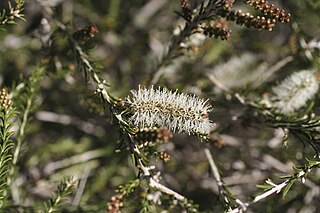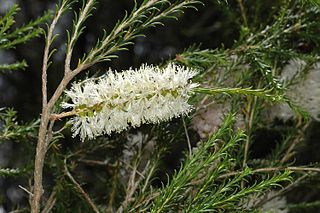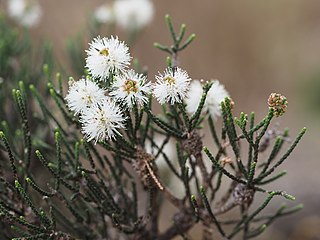
Melaleuca adnata, commonly known as sandhill honey-myrtle, is a plant in the myrtle family, Myrtaceae and is endemic to the south-west of Western Australia. It is a tall shrub with papery bark and spikes of white flowers in spring and early summer.

Melaleuca laxiflora, commonly known as narrow-leaved paperbark, is a woody, spreading shrub in the myrtle family, Myrtaceae and is endemic to the south-west of Western Australia. It is distinguished by its loosely arranged, mostly lateral pink flower spikes and its smooth, fleshy, oil-dotted leaves. It is often cultivated because of its hardiness and attractive flowers.

Melaleuca bracteosa is a low, spreading shrub in the myrtle family, Myrtaceae and is endemic to the south-west of Western Australia. It has tiny, fleshy, non-prickly leaves and cream flowerheads.

Melaleuca ciliosa is a small shrub in the myrtle family, Myrtaceae and is endemic to the south-west of Western Australia. It has bright or pale yellow flowers, an unusual calyx and leaves that are slightly hairy, especially around the edges.

Melaleuca concinna is a small shrub in the myrtle family Myrtaceae and is endemic to the south-west of Western Australia. Its species name translates as " neat" or "pretty" and it is distinguished by having many heads of pink flowers in late spring followed by spherical clusters of woody fruits.

Melaleuca hamulosa is a plant in the myrtle family, Myrtaceae and is endemic to the south-west of Western Australia. It is a broom-like shrub with many stiff, ascending branches and spikes of white or pale mauve flowers in spring or summer.

Melaleuca lateralis is a plant in the myrtle family, Myrtaceae and is endemic to the south-west of Western Australia. It is a showy shrub, well suited to horticulture, distinguished by its very small leaves and small clusters of pink flowers along the older stems.

Melaleuca pauciflora is a shrub in the myrtle family Myrtaceae, endemic to the south-west of Western Australia. Its decussate leaf arrangement and its small heads of white flowers on the sides of its branches are diagnostic. This is probably the least spectacular of all the melaleucas.

Melaleuca sparsiflora is a shrub in the myrtle family Myrtaceae, and is endemic to the south-west of Western Australia. It generally grows in heavy soils on the edges of salt lakes and has only one or two flowers at the ends of it branches, unlike the many-flowered heads or spikes of others in the genus Melaleuca.

Melaleuca thyoides, commonly known as salt lake honey-myrtle is a plant in the myrtle family, Myrtaceae and is endemic to the south-west of Western Australia. It is an erect shrub with grey, papery or fibrous bark and very small, overlapping leaves on thin branchlets. It is a salt tolerant species often found on the edges of salt lakes.

Beaufortia cyrtodonta, commonly known as Stirling Range bottlebrush, is a plant in the myrtle family, Myrtaceae and is endemic to the south-west of Western Australia. It is a compact shrub with crowded leaves which appear greyish due to their covering of fine, soft hairs. It has heads of red flowers in spring and occurs in the Stirling Range district.

Eucalyptus falcata, commonly known as silver mallet or toolyumuck, is a species of mallee or marlock that is endemic to Western Australia. It has smooth bark, lance-shaped to curved adult leaves, flower buds in groups of eleven or thirteen, creamy white or yellowish green flowers and flattened spherical fruit.

Eucalyptus uncinata, commonly known as the hook-leaved mallee, is a species of mallee that is endemic to the southwest of Western Australia. It has smooth bark, lance-shaped adult leaves, flower buds arranged in groups of nine to thirteen, creamy white flowers and barrel-shaped to oval or cylindrical fruit.
Thryptomene mucronulata is a species of flowering plant in the family Myrtaceae and is endemic to Western Australia. It is an erect shrub with upward-pointing, overlapping, egg-shaped leaves with the narrower end towards the base and pink flowers with five petals and ten stamens.

Boronia pulchella, commonly known as the pink boronia, is a plant in the citrus family, Rutaceae and is endemic to a small area in the south-west of Western Australia. It is a slender shrub with rod-like stems, pinnate leaves and deep pink, four-petalled flowers.

Boronia oxyantha is a plant in the citrus family, Rutaceae and is endemic to a small area in the south-west of Western Australia. It is a shrub with many hairy branches, pinnate leaves and pink, four-petalled flowers that have a darker midrib.
Dillwynia divaricata is a species of flowering plant in the family Fabaceae and is endemic to the south-west of Western Australia. It is an erect, spindly shrub with cylindrical, grooved leaves and yellow flowers with brownish markings.
Hibbertia helianthemoides is a species of flowering plant in the family Dilleniaceae and is endemic to a small area in the south-west of Western Australia. It is a prostrate to low-lying, spreading to erect, hairy shrub with hairy foliage, linear leaves and yellow flowers with thirteen stamens.

Hibbertia mucronata is a species of flowering plant in the family Dilleniaceae and is endemic to the south of Western Australia. It is an erect shrub with hairy branches, crowded, thick, tapering linear leaves ending in a sharp point, and golden yellow flowers with five stamens fused at their bases, all on one side of two densely hairy carpels.
Pultenaea purpurea is a species of flowering plant in the family Fabaceae and is endemic to the south of Western Australia. It is a small prostrate shrub with cylindrical leaves and yellow-orange and red flowers.

















